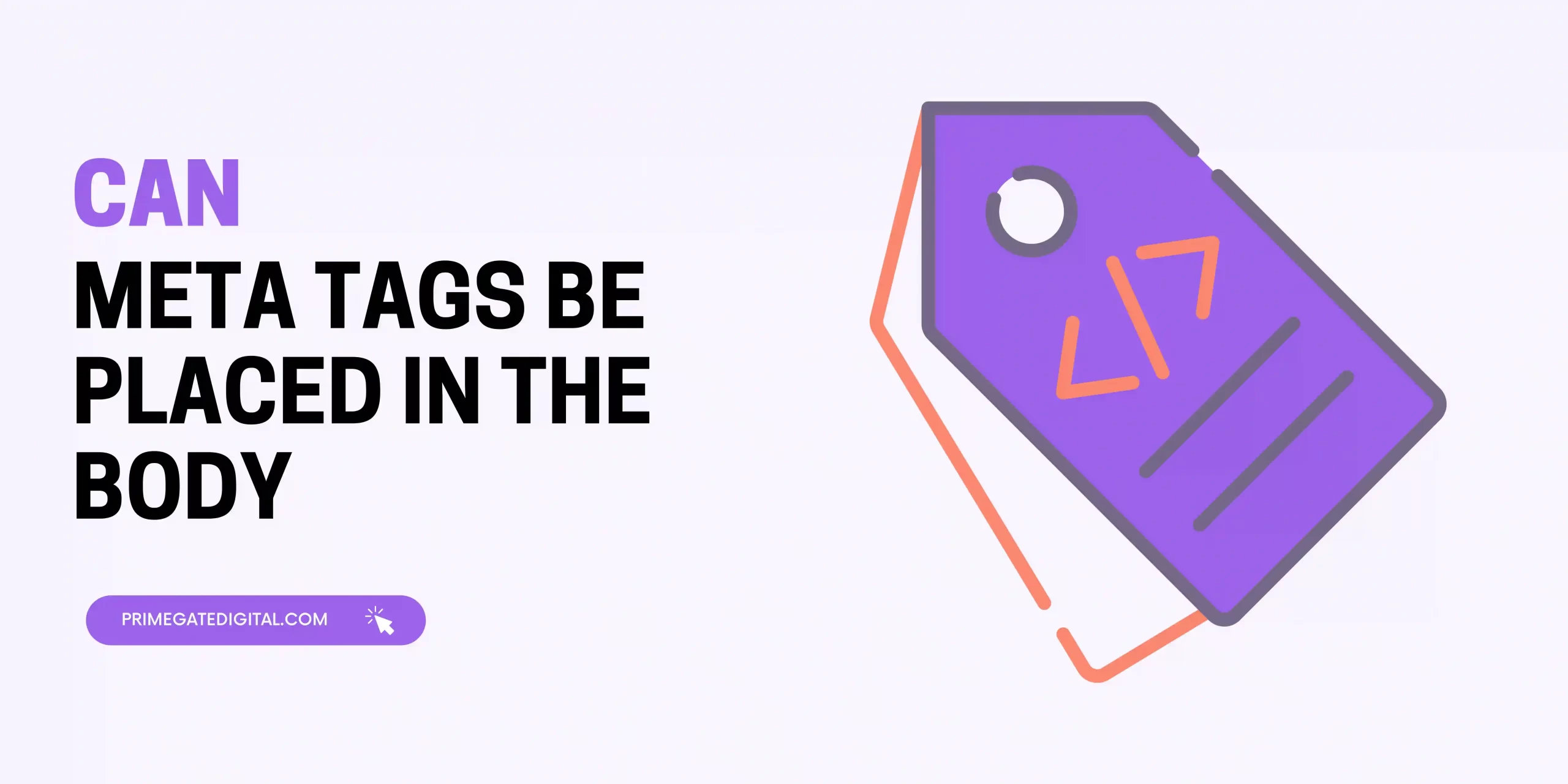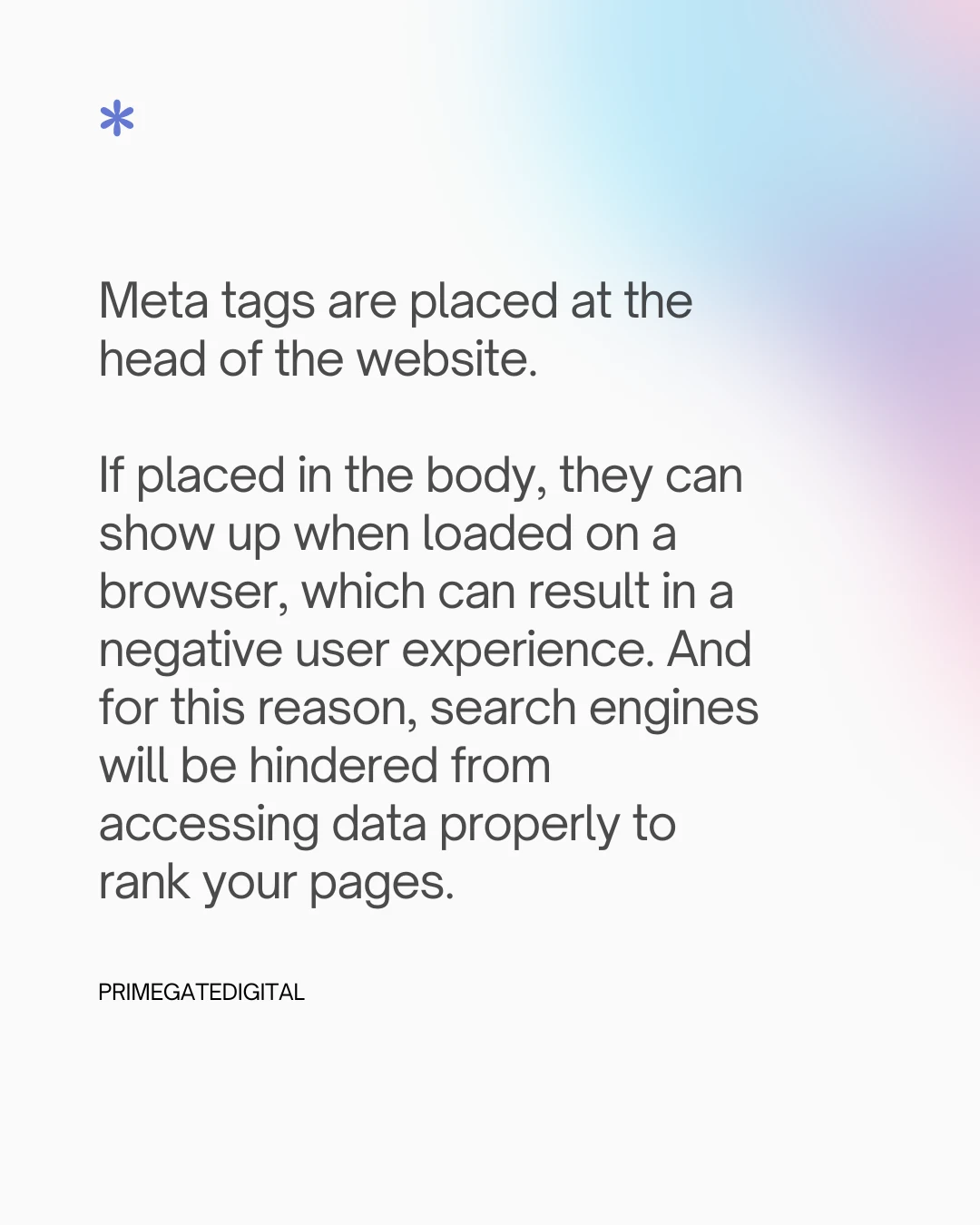Last updated on December 10th, 2023 at 07:33 pm
Also called metadata, meta tags are pieces of code essential for web design and SEO to give information about a page’s content. Meta tags do not show up on pages; they are rather displayed on the source code of websites.
They are placed on the website head. These tags help search engines summarize the page’s content. This way, search engines can easily figure out the page topic and push the pages with the most relevance to searchers.

Meta tags are not placed in the body of a page but at the head of the page. This is the reason it is accessible to search engines and those with the expertise to find the source code of the site.
Meta tags inform search engines about information on a site to assist your content in performing well on search engines such as Google. However, implementing meta tags can be hard if you are unable to add HTML code.
Meta tags are placed at the head of the website.
If placed in the body, they can show up when loaded on a browser, which can result in a negative user experience. And for this reason, search engines will be hindered from accessing data properly to rank your pages.
In instances where your markup is wrong, browsers won’t correctly process your web pages. Thus, it is best practice to place your meta tags in the head. That is where it should be, ideally, because search engines can easily locate them.

How to Place Different Meta Tags
Title tag
The title tag serves as the page title on search result pages. Avoid duplicating title tags.
You have to ensure that your title is unique. There shouldn’t be any confusion between your title tag and the H1 that is placed with your content and takes the place of a title for your page.
Title tags need to have a minimum of 60 characters to prevent being cut off by Google and other search engines.
Also, you can place title tags on your online pages. To do this, navigate to the <title> tag in your source code and input your desired words. Once you are done creating your title tag, it can appear this way:
<title> Title goes here</title>
Title tags are crucial since they assist search engines in figuring out the content of your page.
This can result in search engines figuring out if your page should rank for a specific search term or not. You can also find title tags in the browser tabs, as they help describe the page.
Title tags can even help your target keywords rank properly. They can even encourage users to click on your blog or web content.
This is why your keyword has to be placed at the start of your title, where possible, because of the space limitation.
Furthermore, every page needs to feature a unique title. This will ensure a hassle-free process for both human searchers and search engines.
Meta Description Tag
The meta description is a brief text overview that is placed on the search engine results page under the title.
Your page has to have a distinctive, non-ambiguous, and correct summary of its content.
A meta description has to have a minimum of 160 characters to avoid being cut off in search results.
The bad news is that the nature of your meta description on SERPs doesn’t entirely lie in your hands. Even when written properly, search engines can choose to make changes to your meta-descriptions or showcase another snippet on your page.
To implement the meta description tag on your web page, find the <meta name=” description” content= “Content goes here.”> section of your page’s source code.
Meta description is a crucial textual element as it offers information for human searchers and search engines.
With a proper meta description tag, you can encourage lots of clicks to your site by creating anticipation for what users will see.
Adding keywords to your meta description can assist people in finding your page in a simple way while informing search engines about your page.
Meta descriptions can also give you an idea of the aim of the page and what customers can benefit from as they access it.
You can also carry out user experience testing to find which versions can attract more clicks, assisting you in driving more traffic and getting a better rank.
Meta robots tag
The meta robots tag informs search engines whether to crawl your site or not. This gives them information on whether the page needs to be indexed or crawled.
There are several reasons why these tags are important. However, you have to properly utilise it to crawl and index pages and stay away from others.
Using Index/follow or noIndex/nofollow, you can use robots tags to inform search engines if you want a page to be crawled or indexed.
By labelling a page index, you can inform search engines that you wish it to be listed on search engine results pages.
On the other hand, you can use the follow tag to direct PageRank to any page. A nofollow tag won’t acknowledge or pass link juice to a specific page.
The robots tag has this appearance:
<meta name= “robots” content=noindex, nofollow”>
<meta name= “robots” content=noindex, follow”>
<meta name= “robots” content=index, nofollow”>
Lastly, your goal should determine the kind of tag you will use for a certain page. In our illustration above, the first one informs search engines to neither follow nor index a link. This implies that the page would be ignored by search engines, causing it to have no value for referral traffic.
In the second illustration, while the search engine is directed to ignore the page, it is directed to pass PageRank to the links on the page by following them.
The last illustration informs the search engine to carry out indexation of the page but not to pass link juice or page rank to the links to its content.
You can use a meta robot tag on an individual page, but there should never be more than one. Do not use the three meta robots tags on just one page.
Open Graph tag
Open graph tags are meta tags for message sharing on social media websites like Twitter, LinkedIn, and Instagram.
For instance, if you need data about your web content (like featured images) to be shared on Facebook, you have to use the open graph tag.
These tags function as a way of informing social media websites about the kind of information you would want to showcase after sharing your page on their platforms.
You may have accessed open graph tags before. When you drop a website’s link on social media platforms, it instantly brings up a preview.
The open graph tag is responsible for this preview. You can select a wide variety of open tags. However, they are placed in the head HTML in this manner:
<meta property=”og:xx”>
Your options for what you can put in an open graph include:
<meta property=”og:title”>
<meta property=”og:description”>
<meta property=”og:type”>
<meta property=”og:image”>
<meta property=”og:url”>
<meta property=”og:site_name”>
The title portrays the webpage and its central idea. Feel free to set up your open graph title to be identical to your page title or even amend it based on your audience preference.
As seen in the second example, the description shares an identical function as a meta description. In the third example, type relates to the kind of content. It can be a short video, picture, or audiobook
Furthermore, the open graph image tag informs social media platforms of the kind of image to generate from your page content to become the image of the post.
In the fifth example, the URL serves as the page’s URL. Lastly, to showcase your site’s name, you utilise it via the site name tag, as seen in the sixth example. However, this is not very compulsory.
Meta keyword tag
The meta keyword tag offers information on the keywords you aim to rank for. But a lot of search engine platforms disregard this tag, so it’s now considered irrelevant.
If you misuse this meta keyword tag, you can easily be penalized, negatively affecting your SEO.
When properly used, this tag can give search engines information about your content by showcasing relevant keywords on your page. Please note that Google has stopped using meta keyword tags.
Can Meta Tags Be Placed in the Body FAQ
What are some tips for writing meta titles?
Limit it to 55 characters. It has to be brief and straightforward. If possible, add a keyword or phrase.
Meta tags are HTML codes that are essential for web design. They assist in offering information about a page’s content.
Meta tags are great because they inform search engines about your page and encourage people to click on your page on SERPs.
Conclusion
In this article, we discussed whether it is important to place meta tags in your text body and how to insert them in your content to align with SEO best practices.
 PrimeGate Digital is a Result Driven Blog that strives to go beyond ‘Conventional Digital Marketing’ through digital innovation and performance marketing. We have experience working with world class brands and products.
PrimeGate Digital is a Result Driven Blog that strives to go beyond ‘Conventional Digital Marketing’ through digital innovation and performance marketing. We have experience working with world class brands and products.
